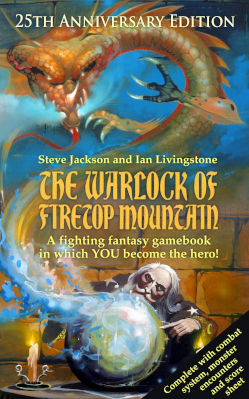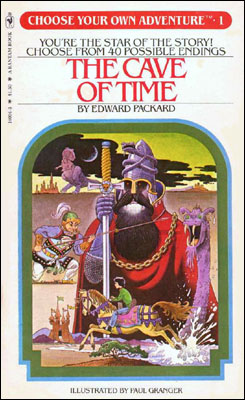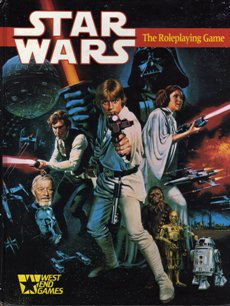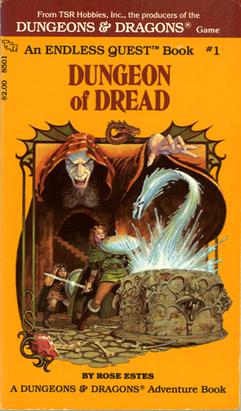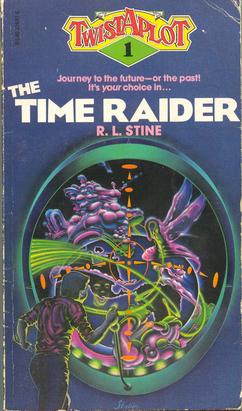History
Origins
There are several examples of early works of art with branching narratives. The romantic novel Consider the Consequences! by Doris Webster and Mary Alden Hopkins was published in the United States in 1930, and boasts "a dozen or more" different endings depending on the "taste of the individual reader". [4] The 1936 play Night of January 16th by Ayn Rand, about a trial, is unusual in that members of the audience are chosen to play the jury and deliver a verdict, which then influences the play's ending: guilty or not guilty. [5] [6]
Also quite early on, the possibility of having stories branching out into several different paths was suggested by Jorge Luis Borges in his short story "An Examination of the Work of Herbert Quain" (1941). This story features an author whose novel is a three-part story containing two branch points, and with nine possible endings. [7] [8] Another story by Borges, titled "The Garden of Forking Paths" (1941), also describes a book with a maze-like narrative, which may have inspired the gamebook form. [8] [9] The children's book Treasure Hunt, published in 1945 in Britain under the name of "Alan George" (probably a pseudonym), is another early example of a story with multiple paths for the reader to follow. [10]
Programmed learning materials, first proposed by B.F. Skinner,[ citation needed ] have been recognized as an early influence on the development of branching path books. [11] This learning method was first applied in the TutorText series of interactive textbooks, published from the late 1950s up until the early 1970s. These books present the reader with a series of problems related to a particular area of study, allowing him or her to choose among several possible answers. If the answer to a problem is correct, the reader moves on to the next problem. If the answer is incorrect, the reader is given feedback and is asked to pick a different answer. This educational technique would form a basis for many later narrative gamebook series. [12]
During the 1960s, authors from several different countries started experimenting with fiction that contained multiple paths and/or endings. Some literary works in this vein include the French-language novel L'ironie du sort (1961) by Paul Guimard, the Spanish-language novels Hopscotch (1963) by Julio Cortázar and Juego de cartas (Card Game, 1964) by Max Aub, and the works of the French literary group known as the Oulipo (1967). [13] [14] [15] [16] Other early experiments include the short stories "Alien Territory" and "The Lost Nose: a Programmed Adventure" (both 1969) by John Sladek, the novel The French Lieutenant's Woman (1969) by John Fowles, and the collection of short stories titled Tante storie per giocare (Many Tales to Play With, 1971) by Italian author Gianni Rodari. [17] [18] [19]
Taken together, these influences may have contributed to the development of several pioneering gamebooks in the 1960s and 1970s. These include Lucky Les by E.W. Hildick (1967), State of Emergency by Dennis Guerrier and Joan Richards (1969), the Swedish-language book Den mystiska påsen (The Mysterious Bag, 1970) by Betty Orr-Nilsson, and the French-language book Histoires comme tu voudras (Stories as You Want Them, 1978) by Marie-Christine Helgerson, among others. [20] [21] [22] [23] [24] [25]
Breakthroughs and popularization
The first gamebook series proper appears to have been Tracker Books, published by Transworld in the UK between 1972 and 1980. This series includes adventures in a variety of genres such as science fiction, mystery, and sports. [ citation needed ] Meanwhile, in the US, The Adventures of You series appeared in 1976–77, with two titles that would later become part of the groundbreaking Choose Your Own Adventure series: Sugarcane Island by Edward Packard and Journey Under the Sea by R. A. Montgomery.
Tabletop role-playing games such as Dungeons & Dragons were another early influence that would contribute in major ways to the development of the gamebook form. The first module which combined a branching-path narrative with a set of role-playing game rules was Buffalo Castle for the Tunnels & Trolls system (1975). Buffalo Castle was innovative for its time, as it allowed the reader to experience a role-playing session without need for a referee. It has been followed by many other solitaire adventures for the T&T system, as well as solos for other tabletop role-playing games.
The first commercially successful series of gamebooks was the Choose Your Own Adventure series establishing the "American" gamebook tradition. The "British" tradition, as exemplified by the Fighting Fantasy series, was, by contrast, slightly younger. British gamebooks differ from the American tradition by having rules more strongly influenced by the game mechanics of roleplaying games. [26]
The US (late 1970s–)
The Adventures of You, a two-book series, authored by Edward Packard and R.A. Montgomery and initially published by Vermont Crossroads Press, laid much of the groundwork for the later surge in popularity of the gamebook format[ citation needed ]. Sugarcane Island by Edward Packard was written in 1969 but did not see publication until 1976. This became a series when Journey Under the Sea by R. A. Montgomery was published in 1977. Two standalone gamebooks authored by Packard would follow, both published by Lippincott: Deadwood City (1978) and The Third Planet from Altair (1979). While these early efforts apparently achieved some popularity with readers, they (and the gamebook format in general) still did not have a publisher with the marketing strength required to make them available to mass audiences.
Packard and Montgomery took the idea of publishing interactive books to Bantam, and thus the Choose Your Own Adventure (CYOA) series was born in 1979, beginning with The Cave of Time . The series became immensely popular worldwide and several titles were translated into more than 25 languages. [27] The series reached the peak of its popularity with children in the 1980s. It was during this period that Bantam released several other interactive series to capitalize on the popularity of the medium (a few examples are: Choose your Own Adventure for Younger Readers, Time Machine and Be An Interplanetary Spy ). Many other American publishers released their own series to compete with CYOA.
One of the most popular competitors seems to have been TSR, who released several branching-path novels based on their own role-playing games. The most famous TSR series was Endless Quest (1982–). Another strong competitor was Ballantine with their Find Your Fate series, which featured adventures in the Indiana Jones, James Bond and Doctor Who universes. Famous author R. L. Stine wrote several books for this line, including The Badlands of Hark, as well as for other series such as Wizards, Warriors and You. Several Choose your Own Adventure spin-offs and many competing series were translated into other languages.
The UK (early 1980s–)
This section needs additional citations for verification .(June 2019) |
One of the most influential and popular gamebook series was the Fighting Fantasy series, which started in 1980 when a Puffin Books representative saw a hall full of 5,000 people playing Dungeons & Dragons and asked Ian Livingstone and Steve Jackson to make a book about role-playing games. They instead offered the idea of a book which simulated the experience of roleplaying games. Within a year they presented a book under the name of The Magic Quest to Puffin which Puffin agreed to publish. Having spent six more months developing the concept it was published under the name of The Warlock of Firetop Mountain in 1982. [28] [29]
Another notable UK gamebook series is Lone Wolf , developed by Joe Dever in 1984. Like Fighting Fantasy, the writer was an experienced Dungeons & Dragons player who developed the setting of Lone Wolf for his campaigns. [30] However the books were also inspired by medieval texts such as Gawain and the Green Knight and Le Morte d'Arthur . [31]
Grailquest is a series of gamebooks written by J.H. Brennan (also in 1984) that were also inspired by the Arthurian legends. Set mainly on Avalon they make use of a dice based system. [32] [ better source needed ]
The Way of the Tiger , a Japan-themed gamebook by Mark Smith and Jamie Thomson (1985), is also a notable UK publication.[ citation needed ]
Outside the English-speaking world (mid 1980s–)
Branching-path books also started to appear during the 1980s in several other countries, including Spain, France, Italy, Mexico, Chile, Denmark and Japan.
Despite the domination of works that have been translated from English in most non-English-speaking countries, a sizable number of original gamebooks—both individual books and series—have been published in various countries; this is especially the case in France (e.g. the La Saga du Prêtre Jean series) [ citation needed ] and in Japan (e.g. Tokyo Sogensha's Super Adventure Game series and Futabasha's Bouken Gamebook series).
In some other countries, publication both of translated series and of original books began in later years. For example, the first original books in Brazil and Italy seem to have appeared in the 1990s.
Eastern Europe (late 1980s–)
Translated editions of Choose your Own Adventure, Fighting Fantasy and other English-language series only appeared in Eastern European countries after the fall of Communism. [33]
Since the mid-1980s, about 90 gamebooks have been published in Poland, not only as printed books, but also as comics, e-books or mobile applications. The author of the largest number of titles (20) is Beniamin Muszyński. Polish gamebooks are regularly written by their fans and published online by "Masz Wybór" (publishing house which has been operating since 2010). [34]
In the 1990s, the gamebook genre became highly popular in Bulgaria for approximately ten years. [35] Whilst internationally well-known series such as Choose Your Own Adventure and Fighting Fantasy were translated for the Bulgarian market, the works of numerous Bulgarian gamebook authors were most popular with readers.
During the popularity peak of gamebooks in Bulgaria, Bulgarian publishing houses believed that only Western authors would sell and, as a consequence, virtually all Bulgarian gamebook authors adopted English pseudonyms. [35] [36] This tradition persisted after their nationality was publicly disclosed. A smaller number of Hungarian authors also adopted Western pseudonyms, in addition to "official titles" that were also in English. [37]
Several adventure gamebooks have been released in the Czech Republic and Russia. In Azerbaijan, Narmin Kamal's novel, Open It's Me, offers the reader a choice to either read the book as a random collection of thirty-nine short stories about the same character, or as a single novel. A photo of the book's hero is published on the final page and the author asks the reader questions about the character.
Decline and resurgence (1990s onward)
The branching-path book commercial boom dwindled in the early 1990s, and the number of new series diminished. However, new branching-path books continue to be published to this day in several countries and languages. Choose Your Own Adventure went on to become the longest running gamebook series with 184 titles. The first run of the series ended in 1998. [38] [39] [40] [41] [42]
R. A. Montgomery started rereleasing some Choose Your Own Adventure titles in 2005. His company has also released some new titles. New books and series continue to be published in other countries to this day. Examples are the 1000 Gefahren series in Germany and the Tú decides la aventura series in Spain. The sixtieth and "lost" entry in the Fighting Fantasy series, Bloodbones , was finally published by Wizard in 2006.
In recent years, the format may be getting a new lease of life on mobile and ebook platforms. [43]
